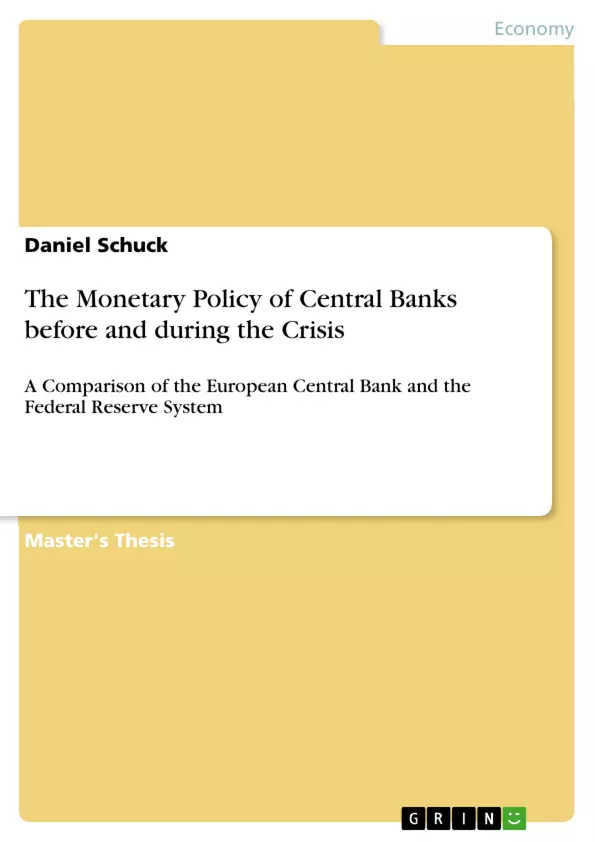The Federal Reserve System and the European Central Bank were both forced to implement unconventional monetary policy measures as a response to the severe impact of the global financial crisis and its aftermath. In the first stage of the global financial crisis, the conventional and unconventional monetary policy measures implemented by the Federal Reserve System and the European Central Bank were fairly similar. Both central banks focused on providing the banking sector with liquidity in order to restore interbank lending as it was a key element of ensuring a functional monetary transmission mechanism. However, when the global financial crisis transformed to a sovereign debt crisis in the euro area in 2010, the European Central Bank faced increasing divergence in sovereign spreads and the potential insolvency of euro area Member States. Therefore, its unconventional monetary policy measures focused on credit easing by purchasing sovereign as well as covered bonds in order to improve banks’ and governments’ funding costs. By contrast, the Federal Reserve System massively purchased government bonds and focused on decreasing interest rates and asset prices through the use of quantitative easing.
Inhaltsverzeichnis (Table of Contents)
- Introduction
- The Global Financial Crisis
- The Onset of the Global Financial Crisis
- Causes of the Global Financial Crisis
- The US Housing Bubble and Innovative Financial Instruments
- Expansive Monetary Policy
- Consequences for the United States Economy
- Consequences for the European Economy
- The Crisis of the European Union
- The Linkage between the Global Financial Crisis and the Crisis of the European Union
- The European Banking Crisis
- The European Sovereign Debt Crisis
- Consequences for the European Economy
- The Role and Importance of Central Banks
- Basics of Central Banks and Monetary Policy
- The Federal Reserve System
- The History of the Federal Reserve System
- Organization and Objectives of the Federal Reserve System
- Monetary Policy of the Federal Reserve System
- The European Central Bank
- The History of the European Central Bank
- Organization and Objectives of the European Central Bank
- Monetary Policy of the European Central Bank
- The Role and Importance of Central Banks during the Crisis
- Monetary Policy of the Federal Reserve System during the Crisis
- Conventional Monetary Policy Measures of the Federal Reserve System
- Unconventional Monetary Policy Measures of the Federal Reserve System
- Short-Term Liquidity Provisions
- Long-Term Liquidity Provisions
- Consequences of the Federal Reserve System's Monetary Policy Responses
- Monetary Policy of the European Central Bank during the Crisis
- Conventional Monetary Policy Measures of the European Central Bank
- Unconventional Monetary Policy Measures of the European Central Bank
- Enhanced Credit Support
- Outright Asset Purchases
- Consequences of the European Central Bank's Monetary Policy Responses
- Comparison of the Federal Reserve System's and the European Central Bank's Monetary Policy Responses
- The use of Conventional and Unconventional Monetary Policy Measures
- The Federal Reserve System's and the European Central Bank's Balance Sheet
- The use of Forward Guidance and Transparency
- Risks and Uncertainties of Unconventional Monetary Policy Measures
Zielsetzung und Themenschwerpunkte (Objectives and Key Themes)
This work aims to compare the monetary policy responses of the Federal Reserve System and the European Central Bank during the Global Financial Crisis. The paper analyzes the causes of the crisis, its consequences for both the US and European economies, and the role played by central banks in mitigating its effects. Key themes explored in this work include:- The impact of the Global Financial Crisis on the US and European economies
- The role of monetary policy in responding to economic crises
- The differences and similarities in the monetary policy approaches of the Federal Reserve System and the European Central Bank
- The effectiveness and consequences of conventional and unconventional monetary policy measures
- The risks and challenges associated with unconventional monetary policy
Zusammenfassung der Kapitel (Chapter Summaries)
The introduction provides an overview of the topic and outlines the objectives of the work. Chapter 2 explores the origins and causes of the Global Financial Crisis, focusing on the US housing bubble, innovative financial instruments, and expansive monetary policy. Chapter 3 examines the impact of the crisis on the European Union, specifically the European banking crisis and the sovereign debt crisis. Chapter 4 delves into the role and importance of central banks, providing a detailed account of the Federal Reserve System and the European Central Bank, including their history, organization, and objectives. Chapter 5 analyzes the monetary policy responses of both central banks during the crisis, comparing conventional and unconventional measures, their consequences, and their effectiveness.Schlüsselwörter (Keywords)
This work focuses on central banking, monetary policy, the Global Financial Crisis, the European Union, the Federal Reserve System, the European Central Bank, conventional and unconventional monetary policy measures, liquidity provision, asset purchases, forward guidance, and transparency.- Quote paper
- Daniel Schuck (Author), 2014, The Monetary Policy of Central Banks before and during the Crisis, Munich, GRIN Verlag, https://www.grin.com/document/302431



